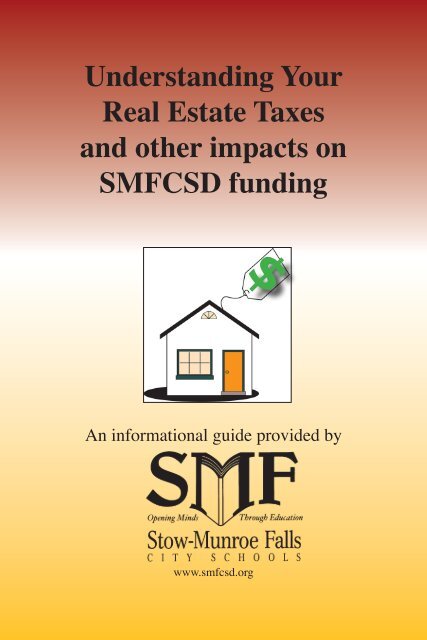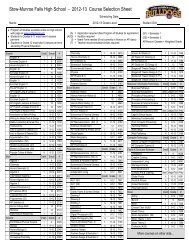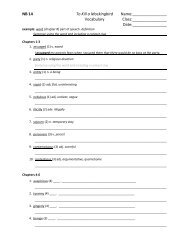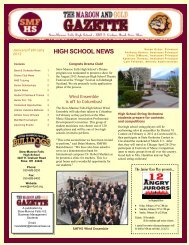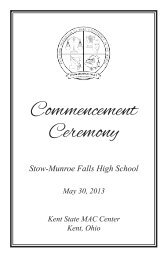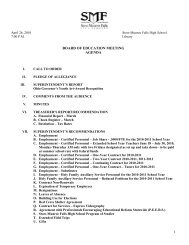Understanding Your Real Estate Taxes and other impacts on ...
Understanding Your Real Estate Taxes and other impacts on ...
Understanding Your Real Estate Taxes and other impacts on ...
You also want an ePaper? Increase the reach of your titles
YUMPU automatically turns print PDFs into web optimized ePapers that Google loves.
<str<strong>on</strong>g>Underst<str<strong>on</strong>g>and</str<strong>on</strong>g>ing</str<strong>on</strong>g> <str<strong>on</strong>g>Your</str<strong>on</strong>g><br />
<str<strong>on</strong>g>Real</str<strong>on</strong>g> <str<strong>on</strong>g>Estate</str<strong>on</strong>g> <str<strong>on</strong>g>Taxes</str<strong>on</strong>g><br />
<str<strong>on</strong>g>and</str<strong>on</strong>g> <str<strong>on</strong>g>other</str<strong>on</strong>g> <str<strong>on</strong>g>impacts</str<strong>on</strong>g> <strong>on</strong><br />
SMFCSD funding<br />
$<br />
An informati<strong>on</strong>al guide provided by<br />
www.smfcsd.org
Fall 2008<br />
Dear Stow-Munroe Falls Citizen:<br />
This brochure has been prepared by the Stow-Munroe Falls City<br />
School District in order to help you underst<str<strong>on</strong>g>and</str<strong>on</strong>g> real estate tax definiti<strong>on</strong>s,<br />
how to calculate your taxes, how much of those taxes go to<br />
Stow-Munroe Falls, <str<strong>on</strong>g>and</str<strong>on</strong>g> <str<strong>on</strong>g>other</str<strong>on</strong>g> valuable informati<strong>on</strong> impacting our<br />
district.<br />
We hope that you find this informati<strong>on</strong> useful <str<strong>on</strong>g>and</str<strong>on</strong>g> invite you to<br />
c<strong>on</strong>tact our offices should you have any questi<strong>on</strong>s.<br />
Sincerely,<br />
Stow-Munroe Falls Board of Educati<strong>on</strong><br />
Denny J. Mariola, President<br />
Dick Spangler, Vice President<br />
Pat Matthews<br />
Karen S. Powers<br />
Karen Wright<br />
Dr. Russell D. J<strong>on</strong>es, Superintendent<br />
Catherine M. Bulgrin, Treasurer/CFO<br />
Thomas G. Adams, Business Manager<br />
4350 Allen Rd., Stow, OH 44224<br />
330-689-5445<br />
http://www.smfcsd.org<br />
3
School Finance Definiti<strong>on</strong>s<br />
<str<strong>on</strong>g>Underst<str<strong>on</strong>g>and</str<strong>on</strong>g>ing</str<strong>on</strong>g> school finances can be difficult because of the terminology<br />
used to describe the process. The following terms are some of the<br />
most comm<strong>on</strong> <strong>on</strong>es used.<br />
Market Value - Term used representing the County Auditor’s appraised<br />
value of a home; this appraisal is adjusted every three years.<br />
Assessed Value - Term representing 35 % of a home’s market value<br />
that a homeowner is assessed to pay taxes.<br />
Millage – The unit of value representing the rate used to calculate property<br />
taxes in Ohio. In cash terms, it is <strong>on</strong>e-tenth of a penny (.001). One mill produces<br />
10 cents for every $100 of assessed value (.001 x 100 = 10); or, $1.00 per $1,000<br />
of assessed value (.001 x 1,000 = 1 ).<br />
Outside Millage - The total millage approved by voters, also referred to<br />
as voted mills.<br />
Inside Millage – Mills that, under the state c<strong>on</strong>stituti<strong>on</strong>, local governments<br />
are permitted to share, aka unvoted mills. They may tax up to 1% of a<br />
property’s assessed value or 10 mills (.010) without the vote of the people. Out<br />
of the 10 unvoted mills, Stow-Munroe Falls City School District’s share equals<br />
5.4 (.0054). Of that, 4.74 mills (.00474) are targeted for general operati<strong>on</strong>s <str<strong>on</strong>g>and</str<strong>on</strong>g><br />
0.66 mills (.00066) are targeted for permanent improvements.<br />
Effective Millage - The rate of taxati<strong>on</strong>, expressed in mills, multiplied<br />
by the assessed value, raises the same dollar amount that was voted. Since 1976,<br />
House Bill 920 prohibited an inflati<strong>on</strong>ary increase in the amount of taxes levied<br />
against real property. In <str<strong>on</strong>g>other</str<strong>on</strong>g> words, as property values increase, the taxes<br />
charged may not be increased; therefore, the millage multiplied by the new value<br />
must be reduced so that the dollars received by the District are equal to the dollar<br />
amount the voted mills would have generated. This reduced millage rate is<br />
referred to as ‘effective’ mills <str<strong>on</strong>g>and</str<strong>on</strong>g> is less than “voted” mills.<br />
Rollback – Under Ohio law, a 10% reducti<strong>on</strong> is applied to Class 1 property<br />
that is reimbursed to school districts by the State. An additi<strong>on</strong>al 2.5% reducti<strong>on</strong><br />
is applied to owner-occupied residential property that is reimbursed by the State.<br />
For owner-occupied property, the total reducti<strong>on</strong> ‘rollback’ is 12.5%.
School Finance Definiti<strong>on</strong>s - c<strong>on</strong>tinued<br />
Homestead Exempti<strong>on</strong> - The Homestead Exempti<strong>on</strong> refers to<br />
the reducti<strong>on</strong> in taxes for senior citizens <str<strong>on</strong>g>and</str<strong>on</strong>g> permanent <str<strong>on</strong>g>and</str<strong>on</strong>g> totally disabled<br />
Ohioans, reducing their property tax burden. The tax exempti<strong>on</strong> is limited to<br />
homestead owners that, defined by Ohio law, own a dwelling <str<strong>on</strong>g>and</str<strong>on</strong>g> up to <strong>on</strong>e acre<br />
of l<str<strong>on</strong>g>and</str<strong>on</strong>g>. The value of the exempti<strong>on</strong> may not exceed the value of the homestead.<br />
This amount is reimbursed to school districts by the state.<br />
General Operating Fund - Public purpose fund used for general<br />
operating purposes that include, but are not limited to, salaries, benefits, utilities,<br />
textbooks, supplies, repairs, equipment, etc.<br />
Permanent Improvement Fund - Fund used to account for<br />
capital outlay that include building improvements, buses, fixed assets, equipment,<br />
<str<strong>on</strong>g>and</str<strong>on</strong>g> textbooks.<br />
<str<strong>on</strong>g>Underst<str<strong>on</strong>g>and</str<strong>on</strong>g>ing</str<strong>on</strong>g> <str<strong>on</strong>g>Your</str<strong>on</strong>g> Property <str<strong>on</strong>g>Taxes</str<strong>on</strong>g><br />
Calculating <str<strong>on</strong>g>Your</str<strong>on</strong>g> <str<strong>on</strong>g>Real</str<strong>on</strong>g> <str<strong>on</strong>g>Estate</str<strong>on</strong>g> <str<strong>on</strong>g>Taxes</str<strong>on</strong>g><br />
Property taxes levied <strong>on</strong> Class 1 <str<strong>on</strong>g>and</str<strong>on</strong>g> Class 2 real property (buildings<br />
<str<strong>on</strong>g>and</str<strong>on</strong>g> grounds held by for-profit businesses <str<strong>on</strong>g>and</str<strong>on</strong>g> individuals) <str<strong>on</strong>g>and</str<strong>on</strong>g> tangible pers<strong>on</strong>al<br />
property (business machinery, equipment <str<strong>on</strong>g>and</str<strong>on</strong>g> inventory) produce the majority of<br />
the School District’s local revenues. <str<strong>on</strong>g>Taxes</str<strong>on</strong>g> are determined based <strong>on</strong> 35% of the<br />
market value of your home <str<strong>on</strong>g>and</str<strong>on</strong>g> property. This is known as the assessed valuati<strong>on</strong><br />
<str<strong>on</strong>g>and</str<strong>on</strong>g> is the <strong>on</strong>ly porti<strong>on</strong> that is subject to taxati<strong>on</strong>. <str<strong>on</strong>g>Taxes</str<strong>on</strong>g> are calculated by<br />
multiplying the fair market value of the homeowner’s property by the County<br />
Auditor’s assessed valuati<strong>on</strong> rate of 35%. For example, if a home has a fair market<br />
value of $100,000, the homeowner is taxed <strong>on</strong> the assessed value of $35,000.<br />
The School District is paid taxes from the County Auditor when they<br />
are collected. Tax bills are generated bi-annually with collecti<strong>on</strong>s for the first<br />
half of the prior year taxes assessed in the subsequent January; <str<strong>on</strong>g>and</str<strong>on</strong>g> the collecti<strong>on</strong>s<br />
of the sec<strong>on</strong>d half of the prior year taxes assessed in the subsequent July.<br />
Sample Tax Calculati<strong>on</strong><br />
Fair Market Value of Home $100,000.00<br />
x Assessed Value Rate x 35%<br />
= Taxable Rate $35,000.00<br />
x Effective Millage Rate x .03365 SMF’s residential tax rate<br />
= Total <str<strong>on</strong>g>Taxes</str<strong>on</strong>g> $1,177.75 (tax year 2007)<br />
Less State Credits (12.5%) – $147.22<br />
Total Annual <str<strong>on</strong>g>Taxes</str<strong>on</strong>g> Owed $1,030.53
Stow-Munroe Falls City School District<br />
Voted/Effective Mills<br />
Type of Levy M<strong>on</strong>th/Year Voted Outside Millage Effective Mills<br />
C<strong>on</strong>tinuing 1976 & Prior 21.54 11.9352710<br />
C<strong>on</strong>tinuing Additi<strong>on</strong>al Nov. 1977 6.00 3.3247500<br />
Emergency (Current Expense) Nov. 2005 4.88 * 4.8800000<br />
Emergency (Current Expense) Nov. 2007 7.67 ** 7.6700000<br />
*Emergency Tax Levy voted for a five-year period generates $4.6 milli<strong>on</strong>,<br />
expiring December 2010.<br />
**Emergency Tax Levy voted for a five-year period generates $7.3 milli<strong>on</strong>,<br />
expiring December 2012.<br />
Unvoted Millage - Mills that, under the state c<strong>on</strong>stituti<strong>on</strong>,<br />
local governments are permitted to share (unvoted mills).<br />
Inside Millage = 5.4 for Stow-Munroe Falls City School District.<br />
Mills voted/unvoted for Stow-Munroe Falls City<br />
School District<br />
Current Total SMFCSD mills:<br />
40.09 General Operating Mills (Voted) = .04009<br />
4.74 General Operating Mills (Unvoted) = .00474<br />
0.66 Permanent Improvement Mills (Unvoted) = .00066<br />
45.49 Total Mills = .04549
How much am I paying in property taxes to the<br />
Stow-Munroe Falls City School District?<br />
Approximately 60% of your property taxes go to the Stow-<br />
Munroe Falls City School District. Summit County receives 22%.<br />
If you are a resident of Stow, the City gets 17%. (Those who live<br />
in a home within the SMFCSD boundaries, but outside the city<br />
limits, pay the same taxes for the School District but pay their local<br />
government taxes for Huds<strong>on</strong>, Kent or Cuyahoga Falls.)<br />
Sample of your tax bill<br />
A mill (.001) produces $1.00 for every $1,000 worth of property<br />
it is levied against.<br />
Tax District Stow-Munroe Falls City School District<br />
Tax Distributi<strong>on</strong>s<br />
For Tax Year 2007 / Collecti<strong>on</strong> Year 2008<br />
Municipality<br />
SUMMIT COUNTY<br />
S-MF CSD<br />
STOW CITY<br />
S-MF PUBLIC LIBRARY<br />
Residential<br />
Agricultural<br />
Commercial<br />
Industrial<br />
Other<br />
Rate Tax Rate Tax<br />
12.395457<br />
33.650021<br />
9.500000<br />
.927222<br />
$390.46<br />
$1,059.98<br />
$299.25<br />
$29.21<br />
12.940177<br />
33.650023<br />
9.500000<br />
.938525<br />
$452.91<br />
$1,177.75<br />
$332.50<br />
$32.85<br />
TOTAL 56.472700 $1,778.90 57.028725 $1,996.01<br />
DISCLAIMER<br />
Tax calculati<strong>on</strong> is based <strong>on</strong> property value of $100,000. The total<br />
amount may be a few dollars off because of rounding. Special assessments<br />
are not included.<br />
Residential tax without 2.5% discount.<br />
Source: Summit County Fiscal Office
Millage Adjustments<br />
H.B. 920 effective millage adjustments<br />
In Ohio, the tax rates charged to the property owners may change<br />
when the tax base increases or decreases. The new assessed value<br />
is multiplied by the number of mills that will generate the voted<br />
dollar amount. In <str<strong>on</strong>g>other</str<strong>on</strong>g> words, the amount of m<strong>on</strong>ey a school<br />
district may collect cannot exceed the dollar amount that was<br />
originally generated when the levy was voted. This occurred when<br />
Ohio passed House Bill 920. As the value of your home increases,<br />
the adjustment to the millage tax rate reflects a decrease; <str<strong>on</strong>g>and</str<strong>on</strong>g>, viceversa,<br />
if the value of your home decreases, the adjustment to the<br />
millage tax rate increases. This adjustment to the millage is known<br />
as ‘effective’ mills <str<strong>on</strong>g>and</str<strong>on</strong>g> results in the school district collecting <strong>on</strong>ly<br />
the same amount as the year it was voted. Therefore, the millage<br />
rate multiplied by the assessed value may be lower than the millage<br />
tax rate that appeared <strong>on</strong> the ballot <str<strong>on</strong>g>and</str<strong>on</strong>g> was voted. A negative impact<br />
to the School District occurs when the community’s valuati<strong>on</strong><br />
overall increases, the District may not receive more than the voted<br />
dollar amount, when that happens the “effective” millage rate is<br />
decreased resulting in taxpayers actually assessed at a lower rate.<br />
The County’s triennial valuati<strong>on</strong> update is scheduled to occur in<br />
calendar year 2008. First-half taxes for calendar year 2008 will be<br />
billed <str<strong>on</strong>g>and</str<strong>on</strong>g> collected beginning in January 2009. Sec<strong>on</strong>d-half taxes<br />
for calendar year 2008 will be billed <str<strong>on</strong>g>and</str<strong>on</strong>g> collected beginning in<br />
July 2009. The School District’s fiscal year begins July 1 <str<strong>on</strong>g>and</str<strong>on</strong>g> runs<br />
through June 30 of the following year.<br />
Inside millage is not reduced as a result of<br />
inflati<strong>on</strong> or deflati<strong>on</strong> nor subject to the<br />
H.B. 920 adjustment.
Millage cannot be adjusted below 20 mills<br />
Laws in Ohio guarantee a minimum of 20 mills for<br />
School Districts (excluding emergency levies <str<strong>on</strong>g>and</str<strong>on</strong>g> b<strong>on</strong>d retirement<br />
levies). This is referred to as the “20 mill floor.” The<br />
Stow-Munroe Falls City School District is c<strong>on</strong>sidered <strong>on</strong> the<br />
“floor.” That means that whenever the “effective” millage drops<br />
below 20 mills, the property owner is taxed at 20 mills of their<br />
assessed valuati<strong>on</strong>.<br />
Some levies are not calculated as part of the minimum<br />
millage, such as emergency levies. These levies are voted for<br />
a specific period of time <str<strong>on</strong>g>and</str<strong>on</strong>g> bring the stated dollar amount<br />
requested from the voters. The millage rate is reduced or increased<br />
to produce the same dollar amount annually. No reducti<strong>on</strong><br />
factor exists for emergency millage.<br />
Other types of levies not impacted by the reducti<strong>on</strong> factor:<br />
• Income Tax levy<br />
• B<strong>on</strong>d levy
The School District Resources<br />
The Stow-Munroe Falls City School District (SMFCSD)<br />
receives m<strong>on</strong>ey from Local, State <str<strong>on</strong>g>and</str<strong>on</strong>g> Federal sources. The majority<br />
of revenues the District receives come from the local <str<strong>on</strong>g>and</str<strong>on</strong>g> state<br />
sources. The local source comes from property taxes <str<strong>on</strong>g>and</str<strong>on</strong>g> the state<br />
source comes from the State of Ohio. In fiscal year 2007, SMFCSD<br />
received 58% of its revenues from property taxes <str<strong>on</strong>g>and</str<strong>on</strong>g> 39% from<br />
state sources.<br />
Federal sources provide federal financial assistance in the<br />
form of grants to be used for restrictive purposes. The State also<br />
provides financial assistance in the form of grants to be used for<br />
restrictive purposes. State law m<str<strong>on</strong>g>and</str<strong>on</strong>g>ates that all grant dollars be<br />
accounted for in separate funds <str<strong>on</strong>g>and</str<strong>on</strong>g> cannot be co-mingled with the<br />
District’s general operating funds.<br />
10
Where the M<strong>on</strong>ey Goes<br />
Educati<strong>on</strong> is heavily reliant <strong>on</strong> people.<br />
In 2007, 84% of our resources were spent <strong>on</strong> wages <str<strong>on</strong>g>and</str<strong>on</strong>g><br />
benefits with 16 % spent <strong>on</strong> instructi<strong>on</strong>al supplies for the<br />
classroom, custodial <str<strong>on</strong>g>and</str<strong>on</strong>g> maintenance supplies, utilities,<br />
fuel, textbooks, county auditor <str<strong>on</strong>g>and</str<strong>on</strong>g> county treasurers’ fees,<br />
debt <str<strong>on</strong>g>and</str<strong>on</strong>g> capital outlay, etc.<br />
11
Other factors that affect<br />
School District Funding<br />
The State requires Boards of Educati<strong>on</strong> to functi<strong>on</strong> like a “business.”<br />
The business of schools produces an ‘intangible product’ unlike<br />
a business that produces a saleable product for distributi<strong>on</strong> <str<strong>on</strong>g>and</str<strong>on</strong>g><br />
profit. Also, where a business may sell its product for an increased<br />
price to cover its cost <str<strong>on</strong>g>and</str<strong>on</strong>g> create a profit, schools must rely <strong>on</strong><br />
the local community’s taxes <str<strong>on</strong>g>and</str<strong>on</strong>g> the state for funds to operate. In<br />
order for schools to increase their revenues, they are faced with the<br />
dilemma of asking the c<strong>on</strong>stituents to increase their property taxes<br />
to cover our cost of living <str<strong>on</strong>g>and</str<strong>on</strong>g> cost of doing business increases as<br />
well as covering additi<strong>on</strong>al expenses, some of which are indicated<br />
below.<br />
Over the years, the legislature has passed many m<str<strong>on</strong>g>and</str<strong>on</strong>g>ates that<br />
are either unfunded or under-funded by the State, causing the<br />
local community to bear the costs. Some of these are:<br />
Collective Bargaining (1983)<br />
Charter Schools (1992)<br />
Fingerprinting <str<strong>on</strong>g>and</str<strong>on</strong>g> background checks (1993)<br />
EMIS (1998)<br />
No Child Left Behind (NCLB) (2001)<br />
Teacher Certificati<strong>on</strong> law changing to Licensure requiring<br />
MA degree that could be a permanent certificate<br />
requiring a BA degree<br />
Increasing the number of High School Credits needed for<br />
graduati<strong>on</strong> (1950, 1960, 1998, 2003)<br />
Special Educati<strong>on</strong> m<str<strong>on</strong>g>and</str<strong>on</strong>g>ates<br />
12
The Legislature also passed HB 920 (1976) that eliminates the<br />
growth in real property taxes, as well as HB 95 (2000) that began<br />
phasing out tangible pers<strong>on</strong>al property tax owed by businesses<br />
<str<strong>on</strong>g>and</str<strong>on</strong>g> HB 66 (2005) that accelerated the phase out to zero by 2010.<br />
The state is holding districts harmless for the first five years of the<br />
phase-out of the Tangible Tax by reimbursing districts for their loss<br />
of revenue. However, beginning in 2012 through 2018 the state<br />
will gradually eliminate the reimbursements forcing the District to<br />
go to the voters to replace those dollars. The cost of this tax loss<br />
to the Stow Munroe Falls school district is $4 milli<strong>on</strong> or 8% of<br />
the district’s revenue source.<br />
Over the past several years, the state has eliminated the Cost of<br />
Doing Business Factor. This was a multiplier <strong>on</strong> the foundati<strong>on</strong><br />
m<strong>on</strong>ey from the state that was used to equalize the cost of inflati<strong>on</strong>;<br />
it varied by district. This eliminated approximately $750,000<br />
from the State’s funding to the Stow-Munroe Falls City School<br />
District.<br />
13
Who determines how much I pay in taxes?<br />
1. The State Legislature determines the level of state<br />
aid given to schools by setting the amount of homestead<br />
credit <str<strong>on</strong>g>and</str<strong>on</strong>g> “inside” millage.<br />
2. The Summit County Auditor assigns each piece<br />
of property a market value <str<strong>on</strong>g>and</str<strong>on</strong>g> classificati<strong>on</strong> such as residential,<br />
agricultural, etc.<br />
3. The Stow Munroe Falls School Board determines<br />
the needs of the district to provide each student with<br />
an adequate <str<strong>on</strong>g>and</str<strong>on</strong>g> efficient educati<strong>on</strong> <str<strong>on</strong>g>and</str<strong>on</strong>g>, if need warrants,<br />
they ask for tax dollars to meet those needs. The County Auditor<br />
determines the mills needed to raise the dollars – hence<br />
a levy is placed before the voters.<br />
4. The Voters must approve a levy request at the ballot<br />
box for it to be implemented.<br />
How does the School District determine<br />
how much to levy?<br />
The district must address increasing costs when current<br />
revenue sources are flat-lined. The <strong>on</strong>ly authority to increase<br />
revenues the School Board has is through a property or income tax<br />
levied <strong>on</strong> the c<strong>on</strong>stituents. There is no authority to ask for a sales<br />
tax. The Treasurer by law must submit a five year forecast twice a<br />
year to the Ohio Department of Educati<strong>on</strong>. The Five-Year Forecast<br />
is used as a management tool to determine the Districts future revenues<br />
<str<strong>on</strong>g>and</str<strong>on</strong>g> expenses with assumpti<strong>on</strong>s that are based <strong>on</strong> historical<br />
trend <str<strong>on</strong>g>and</str<strong>on</strong>g> available informati<strong>on</strong> at the time of the projecti<strong>on</strong>. Available<br />
informati<strong>on</strong> would include, but not be limited to, the state of<br />
the ec<strong>on</strong>omy, current market c<strong>on</strong>diti<strong>on</strong>s, <str<strong>on</strong>g>and</str<strong>on</strong>g> local ec<strong>on</strong>omic indicators.<br />
Current budgets are evaluated addressing the basic needs of<br />
the students <str<strong>on</strong>g>and</str<strong>on</strong>g> their educati<strong>on</strong>. Calculati<strong>on</strong>s of levy amounts are<br />
modeled into the forecast to determine how many mills should be<br />
levied to stave off future deficits. By law, schools are not allowed<br />
to operate with a deficit or close their doors <str<strong>on</strong>g>and</str<strong>on</strong>g> cease operati<strong>on</strong>.<br />
14
What is the future of my property taxes<br />
paid towards Schools?<br />
The Stow-Munroe Falls City School District is rated an<br />
Excellent District for providing programs <str<strong>on</strong>g>and</str<strong>on</strong>g> services to our students<br />
that result in their achieving success in college <str<strong>on</strong>g>and</str<strong>on</strong>g> in future<br />
careers. Our “Cost-per-pupil” rate of $8,796 for fiscal year 2007<br />
is lower than similar districts that pay $9,050 annually per student<br />
<str<strong>on</strong>g>and</str<strong>on</strong>g> is less than the state average cost per student of $9,623. (Taken<br />
from Ohio Department of Educati<strong>on</strong> District Profile Report formerly<br />
known as the CUPP Report)<br />
Based <strong>on</strong> the current school funding structure in Ohio, it<br />
will be necessary for schools in Ohio to c<strong>on</strong>tinually ask for tax<br />
increases from its c<strong>on</strong>stituents in order to c<strong>on</strong>tinue doing business.<br />
The Stow-Munroe Falls City School District’s revenue remains<br />
flat-lined until the passage of a new levy. As costs increase, new<br />
levies must be proposed in order to meet its daily operati<strong>on</strong>s.<br />
Fiscal Year 2007<br />
Estimated Daily Cost to Educate a Student<br />
$60<br />
$50<br />
$49.18<br />
$40<br />
$30<br />
$20<br />
$21.19<br />
$10<br />
$-<br />
Daily Cost<br />
to Educate<br />
a Student<br />
Resident<br />
Share<br />
of Daily Cost<br />
15
Stow-Munroe Falls City Schools<br />
4350 Allen Rd.<br />
Stow, OH 44224<br />
1909 2009<br />
SMFHS<br />
100 th GRADUATING CLASS<br />
A Century<br />
of Excellence Postal Customer<br />
NON-PROFIT ORG.<br />
U.S. POSTAGE<br />
PAID<br />
CUY. FALLS, OHIO<br />
Permit No. 329


